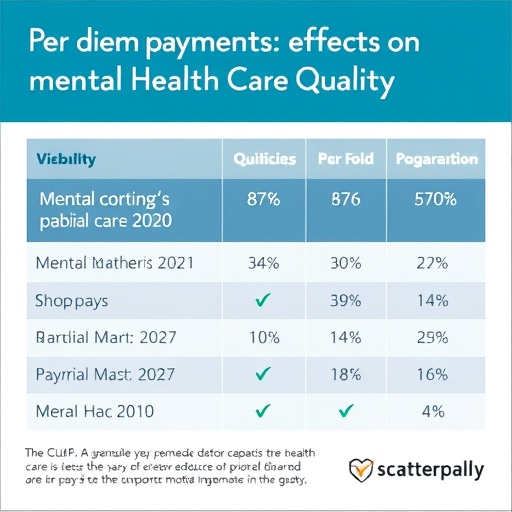In recent years, the financial models employed in healthcare systems have generated considerable debate, particularly regarding their efficiency and the quality of care delivered. A pivotal aspect of these discussions revolves around per diem payment structures, a system that charges healthcare providers a fixed amount for each day a patient remains in care. This model has been scrutinized for its potential effects on medical expenditure and care outcomes, particularly for vulnerable populations such as patients with mental health disorders. A recent study by Pan and Liu delves into this issue, exploring the impact of per diem payment systems on medical expenditure, service efficiency, and the overall quality of care received by these patients.
The researchers employed an interrupted time series study design, a robust methodological approach often used in health economics research. By analyzing pre- and post-intervention data, Pan and Liu aimed to provide a clearer picture of the consequences wrought by the transition to a per diem payment model. This approach allows for the examination of trends over time, which is particularly useful in healthcare contexts where other variables may confound the effects of policy changes. The implications of their findings are significant, suggesting that financial structures in healthcare can profoundly influence both cost and care effectiveness.
One of the critical elements of the study lies in the quantification of medical expenditures following the implementation of a per diem payment model. The findings indicate that per diem payment systems tend to limit patients’ length of stay in hospital settings. This has repercussions, not only for financial costs borne by healthcare systems but also for the quality of care patients receive. While shorter hospital stays may enhance the efficiency of resource use, they may also leave certain mental health needs unaddressed, potentially compromising patient outcomes.
Moreover, the analysis revealed a notable relationship between the payment structure and service efficiency. With financial incentives aligned toward rapid discharges, healthcare practitioners may prioritize cost-saving measures over comprehensive care. This situation poses risks, especially for patients whose conditions require prolonged treatment and monitoring. The tension between economic efficiency and the imperative for quality care highlights a fundamental challenge within contemporary healthcare systems, evaluated through the lens of this new study.
The question of care quality also emerged prominently in the findings reported by Pan and Liu. By scrutinizing various aspects of patient care, the researchers identified trends indicating that the older models of care, characterized by more flexible payment structures, tended to yield better health outcomes for patients with mental disorders. The findings provide a stark reminder of the importance of financial models that can appropriately encapsulate the complexities of patient needs while incentivizing optimal care practices.
Critically, the implications of these findings extend beyond mere economics. They challenge policymakers to consider the broader ramifications of the payment structures they endorse. Health care systems must balance the fiscal sustainability of services with the ethical considerations surrounding patient care. The study serves as a clarion call for a nuanced understanding of how payment models impact not just costs, but also the very fabric of care delivery.
Further examination of the data revealed insights into patient populations most affected by the shifts toward per diem systems. It appears that individuals with severe mental disorders were disproportionately adversely impacted, likely due to the intricate nature of their conditions. These challenges underscore the need for tailored interventions that consider the unique needs of this demographic, as painting all patients with the same brush undercuts the reality of their diverse clinical presentations.
Moving forward, this research sets the stage for further inquiry into how alternative payment systems might better serve mental health populations. It is essential that future healthcare policies reflect an understanding of the medical, psychological, and social dimensions that influence patient care. By engaging in ongoing dialogue about payment structures, stakeholders can work toward a more equitable and effective healthcare system.
Additionally, the study prompts a reevaluation of perceptions surrounding mental health care more broadly. As mental health receives increased recognition as a vital component of overall health, the necessity for effective and compassionate care should be reflected in the funding models that support it. This calls for a modernization of existing payment frameworks to align them more closely with the realities faced by healthcare providers and the populations they serve.
In conclusion, the study by Pan and Liu sheds light on significant concerns regarding per diem payment structures and their ramifications for patient care in mental health settings. The insights gleaned from this research are not merely academic; they have palpable implications for how care is delivered, financed, and received in our increasingly complex healthcare landscape. Policymakers and healthcare administrators alike must take heed of these findings and consider their broader implications on health equity, service delivery, and patient outcomes.
Such a conversation is vital as we strive to optimize the healthcare systems that underpin our societies. The fusion of clinical excellence with fiscal responsibility remains a delicate yet necessary balance to achieve an improved standard of care for all patients, especially those confronting the challenges of mental disorders. Through continued research and collaborative efforts, we can hope to refine our approaches to healthcare financing in ways that elevate patient care above all else.
Subject of Research: Impact of per diem payment on medical expenditure, service efficiency, and quality of care for patients with mental disorders.
Article Title: Impact of per diem payment on medical expenditure, service efficiency, and quality of care for patients with mental disorders: an interrupted time series study.
Article References:
Pan, Y., Liu, Z. Impact of per diem payment on medical expenditure, service efficiency, and quality of care for patients with mental disorders: an interrupted time series study.
BMC Health Serv Res 25, 1298 (2025). https://doi.org/10.1186/s12913-025-13419-9
Image Credits: AI Generated
DOI: 10.1186/s12913-025-13419-9
Keywords: per diem payment, medical expenditure, service efficiency, quality of care, mental health disorders, healthcare policy.
Tags: effects of payment structures on care outcomeshealth economics research methodshealthcare financial modelshealthcare system efficiency debatesinterrupted time series study designmedical expenditure impactmental health care qualityper diem payment modelspolicy changes in healthcarequality of care for mental health patientsservice efficiency in healthcarevulnerable populations in healthcare





